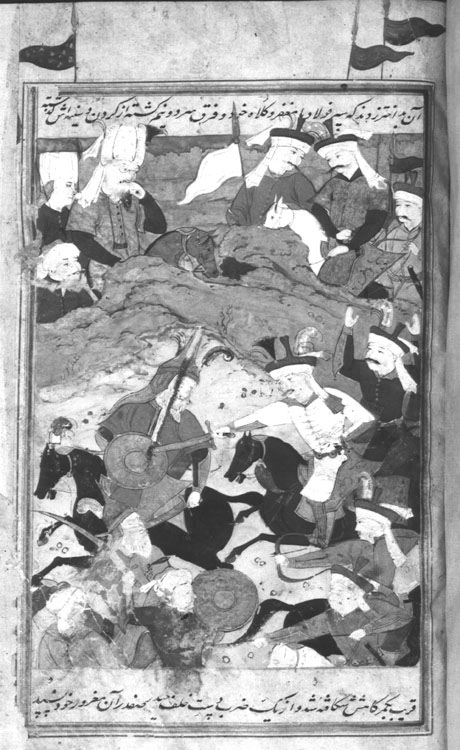Date of this event: 920/1514.
The only battle with the Ottomans in which Shah Esmāʿil took part was fought at Čālderān on 2 Rajab 920/23 August 1514. A renowned Ottoman, identified in this text as Ankoǧli, but apparently the same as the Malqoč-oǧlu cited by Monshi, was constantly boasting to his compatriots that there was no one in the Safavid ranks worthy of giving battle to him except the shah himself. During the battle he managed to reach the Safavid center and challenge the shah. Esmāʿil galloped out to meet him, and delivered a single blow of his sword with such fury and hostility that it cleft his opponent in half, dividing shield. helmet, head, and continuing through his neck and chest to the waist.
The painting depicts the two combatants near the center of the composition. True to the text, Esmāʿil lunges forward in the saddle and cleaves his opponent down the middle. In the upper left, appearing from behind a ridge, are three individuals, two of whom are wearing Ottoman headgear. The most prominent of them, with his finger raised to his lip in a sign of astonishment, can be identified by the black aigrette on his hat as the Ottoman emperor, Sultan Selim. There are nine other individuals in the scene: six qezelbāš and three Ottomans. Directly behind Esmāʿil is a qezelbāš emir who raises his hands in alarm. In the upper right, partially concealed behind a ridge , are three more Safavids who balance the Sultan Selim group on the opposite side. And in the lower foreground two additional ghåzis, one with a lance, and the other with a bow, who battle with three Ottomans armed with sword and shield.
Painting: 16.7 x 12.0 cm. One line of text above and below the painting. Frame encloses painting and text; three standards protrude beyond the frame into the upper margin. The painting has been damaged in several places with flaking and wear, but the most serious damage has been confined to the lower corner where there are several tears, a sizable smudge, and most of the faces have been obliterated. Unsigned.
For another version of this subject see Ms. M, folio 298v.
Painting references:
Unpublished.
Text X-references:
See Muntaẓer-Ṣāḥeb_1970, pp.521-22 for this event in the History of Shah Esmāʿil.
See Savory, SA_1979, p.69 for this event in the History of Shah ʿĀbbās.
Robert Eng
Last updated: November 29, 2010
